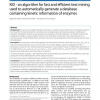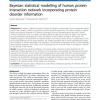65 search results - page 7 / 13 » Methods for Random Modularization of Biological Networks |
BMCBI
2007
13 years 7 months ago
2007
Background: Analyzing differential-gene-expression data in the context of protein-interaction networks (PINs) yields information on the functional cellular status. PINs can be for...
RECOMB
2003
Springer
14 years 8 months ago
2003
Springer
We develop a new framework for inferring models of transcriptional regulation. The models in this approach, which we call physical models, are constructed on the basis of verifiab...
BMCBI
2010
13 years 7 months ago
2010
Background: The amount of available biological information is rapidly increasing and the focus of biological research has moved from single components to networks and even larger ...
BMCBI
2010
13 years 7 months ago
2010
Background: We present a statistical method of analysis of biological networks based on the exponential random graph model, namely p2-model, as opposed to previous descriptive app...
BMCBI
2010
13 years 7 months ago
2010
Background: It has been long well known that genes do not act alone; rather groups of genes act in consort during a biological process. Consequently, the expression levels of gene...


